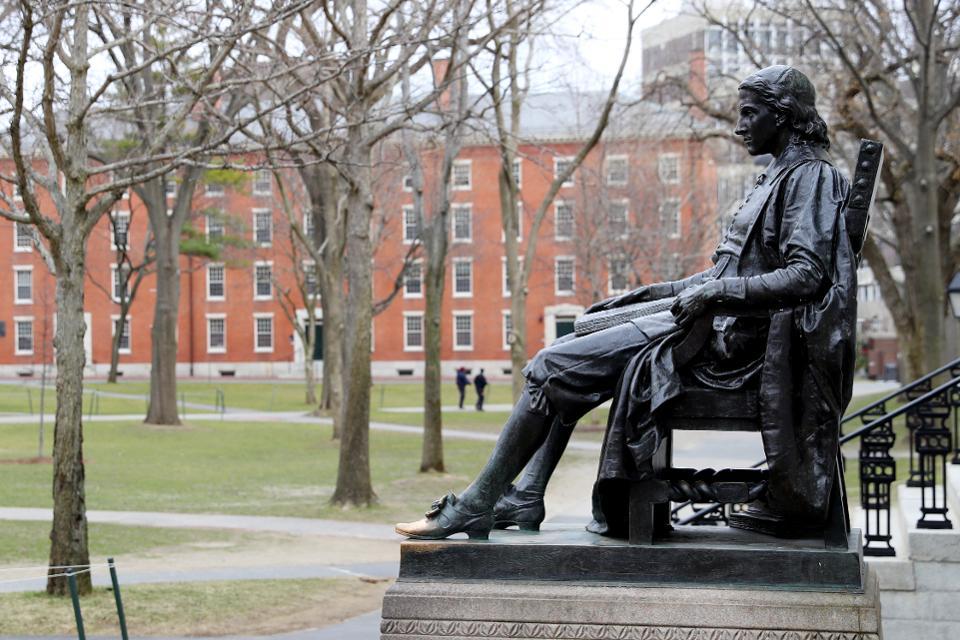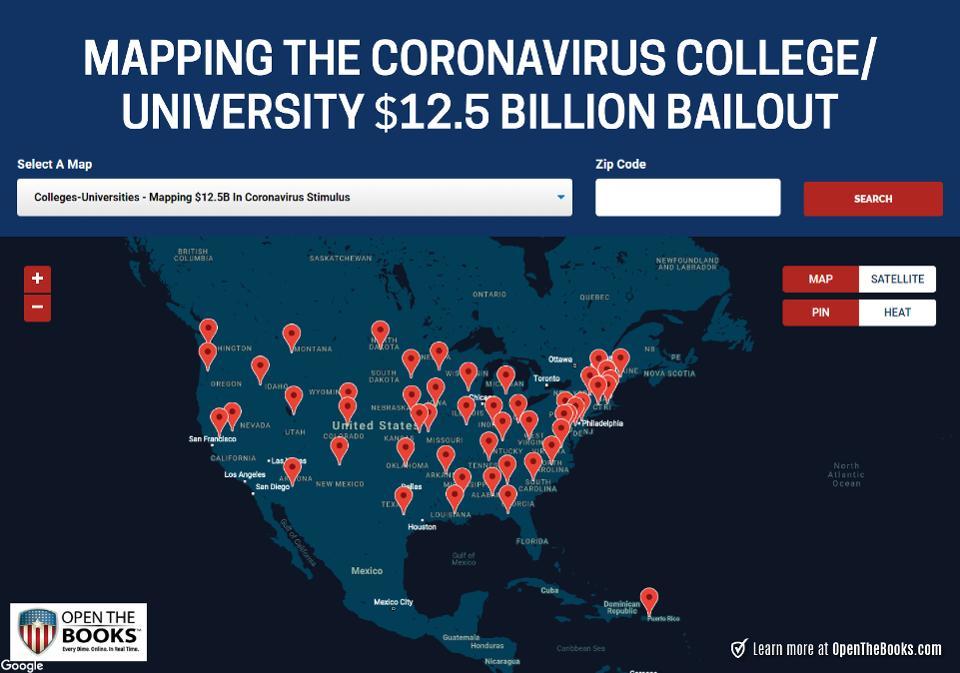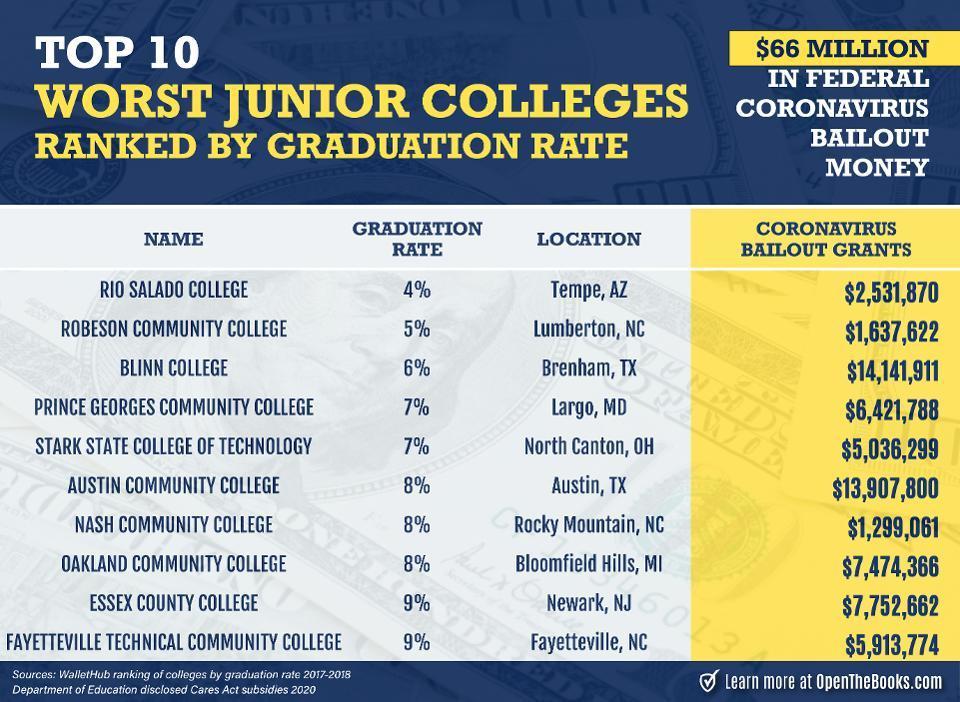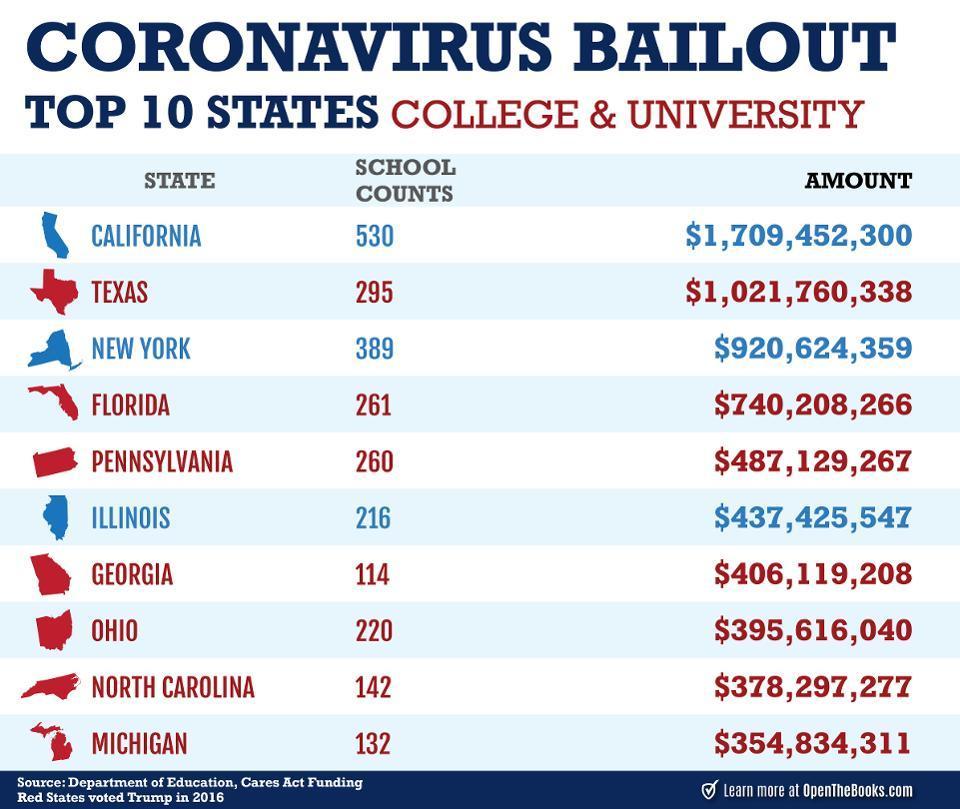America’s Colleges Awarded $12.5 Billion In COVID-19 Bailout – Who Got It And How Much?
Submitted by Adam Andzejewski, first published in Forbes,
Harvard decided not to apply for their $9 million share of the $2.2 trillion CARES Act – the Coronavirus Aid, Relief, and Economic Security Act, after President Donald Trump brought the issue into the national limelight. Princeton followed suit.
The other Ivies are still deciding whether to accept up to $62.9 million in CARES money — despite their collective endowment of $140 billion. However, our auditors at OpenTheBooks.com discovered that these funds are just the tip of the iceberg.
We scoured the backend of the U.S. Department of Education website and found the full database: 5,137 colleges and universities that were awarded $12.5 billion in coronavirus relief. None of it has to be paid back.
We created an interactive map on a state-by-state basis of the colleges and universities that were allocated the aid. (The institutions still must apply for the funds in order to receive it.)
Just click a pin (state) and scroll down to the chart beneath the map to see which college (by name) can receive how much taxpayer money. For example, you’ll find 530 schools in California, 389 in New York, 295 in Texas, 261 in Florida, and 260 in Pennsylvania.
The five colleges and universities allocated the most money were Arizona State University ($63.5 million); Penn State ($55 million); Rutgers, The State University of New Jersey ($54.1 million); University of Central Florida ($51.1 million); and Miami Dade College ($49.1 million).
Responding to our request for comment, Arizona State applauded and Central Florida was “grateful” for CARES Act funding.
Here are five facts you probably didn’t know about the coronavirus bailout of America’s colleges and universities:
#1. The $350 Billion Club: The 25 universities with the largest endowments were allocated $801.3 million in coronavirus subsidies. These wealthy institutions had $350 billion in their collective endowments.
Notre Dame was allocated a $5.8 million share ($8.4 billion endowment). However, the school told us that they aren’t going to even apply for the funds. Their share will be returned to the U.S. Treasury Department’s general fund.
Here are the allocations for some other wealthy schools: Ohio State University $42 million ($3.6 billion endowment); Northwestern University $8.5 million ($9.7 billion endowment); The University of Chicago $6.2 million ($7 billion endowment); and Massachusetts Institute of Technology (MIT) $5 million ($13.2 billion endowment).
An MIT spokesperson responded to our request for comment:
“MIT senior leaders are still reviewing information from the government, considering the range of needs facing our students, and determining how best to proceed.”
The biggest systems are allocated the most bailout money: Penn State $55 million ($3.6 billion endowment); Texas A&M $82.2 million ($10.5 billion endowment); University of Texas $173 million ($24.2 billion endowment); and the University of California $260 million ($8.3 billion endowment).
Responding to our request for comment, a Penn State spokesperson defended their share:
“The University is grateful that the Department of Education prioritized this funding to support students who have the most need… The other half of the funds will be used to help keep Penn State employees working…”
#2. Big 10 Conference is #1 – In the battle among the major conferences, the fourteen schools of the Big 10 Conference were allocated the most bailout money ($393 million) – an average of $28 million per institution.
For example, Indiana University (Big 10) has an endowment of $2.4 billion, yet they will receive $24.6 million in bailout monies. Recently, a student journalist failed to convince the university to use their endowment to mitigate student tuition. However, we found the president of the school made $3.5 million (2017-2019) and the IU Foundation employed his wife ($303,641) and daughter ($58,271).
Responding to our request for comment, IU decided to take the bailout and claims their billion dollar endowment can’t help out in the crisis because donors earmarked their gifts for other purposes.
The Pacific-12 Conference (Pac-12) was allocated $318 million. The University of Oregon will receive $16.1 million even though the school’s endowment approached $1 billion. The university chancellor earned $738,000 in salary with up to $200,000 in additional bonuses. Before the virus, students had been protesting program cuts and tuition hikes.
The Southeastern Conference (SEC) has fourteen schools and was allocated $280.2 million. The University of Alabama was allocated $20.7 million, despite the fact that the school employs the most highly compensated public employee in the nation. In the last three years, Alabama paid their head football coach Nick Saban a total of $29.2 million.
Responding to our request for comment, The University of Alabama contended that athletics are self supporting.
The fifteen schools of the Atlantic Coast Conference (ACC) collected just $194 million in aid.
#3. Worst junior colleges: The 50 worst community colleges scored by WalletHub received $200 million in taxpayer funding. Collectively, these schools had a graduation rate of 12.3 percent (2017-2018).
The top 10 worst schools were allocated $66 million despite reporting graduation rates between 4-9 percent. The U.S. taxpayer may want to know why these schools are even allowed to operate.
#4. Beauty schools called cosmetology colleges: Four-hundred and nine “cosmetology colleges” were allocated $102.7 million in bailout money. Many times these schools charge higher student tuition prices than established universities. It’s a phenomenon whereby taxpayer dollars – Pell grants and student loans – drive up the cost of education.
The Empire Beauty School was allocated the most coronavirus funds (nearly $18 million) even though the school admits to charging up to $22,100 in tuition and fees – exceeding the in-state tuition costs of all Big Ten universities except Northwestern. It’s a 35-40 week program and graduates are qualified to cut hair, manicure nails, and do massage therapy.
Empire Beauty did not respond to our request for comment.
Other non-traditional colleges were allocated money, including a professional golf college ($84,000); two schools of wooden boat building ($107,000); and a bartending and gambling school ($558,000). Twenty-four art academies collected a combined $29 million.
#5. Red states vs. blue states: Our auditors found that colleges and universities located in the thirty states that voted for President Trump in 2016 were allocated $6.8 billion. Institutions located in states that did not vote for Trump were allocated $5.4 billion.
Those summary numbers obscure the fact that the blue states were allocated more money on average than the red states, $270 million vs. $222 million. This is because blue states had more higher ed institutions than the red states. In the twenty blue states, there were 2,155 institutions allocated aid (an average of 108 schools per state). The thirty red states had 2,853 institutions (an average of 95 schools per state).
The rest of the aid, approximately $389 million, was allocated to the 128 institutions located in Washington, D.C., or U.S. territories, i.e. Puerto Rico, Guam, etc.
So, who was not allocated coronavirus bailout money?
There are sixteen U.S. colleges and universities that do not accept federal money. The most prominent are Hillsdale College in Michigan, Grove City College in Pennsylvania, and Patrick Henry College in Virginia.
In February, our team audited Hillsdale’s assertion of no federal funding and found their statements 100 percent true. Hillsdale has never taken any aid directly from the federal government. This has allowed the college to operate without government interference and with maximum institutional independence.
None of the sixteen colleges were allocated any coronavirus bailout money, either. These schools decided long ago to pay their own way.
Tyler Durden
Fri, 05/08/2020 – 12:10![]()
Zero Hedge’s mission is to widen the scope of financial, economic and political information available to the professional investing public, to skeptically examine and, where necessary, attack the flaccid institution that financial journalism has become, to liberate oppressed knowledge, to provide analysis uninhibited by political constraint and to facilitate information’s unending quest for freedom. Visit https://www.zerohedge.com




